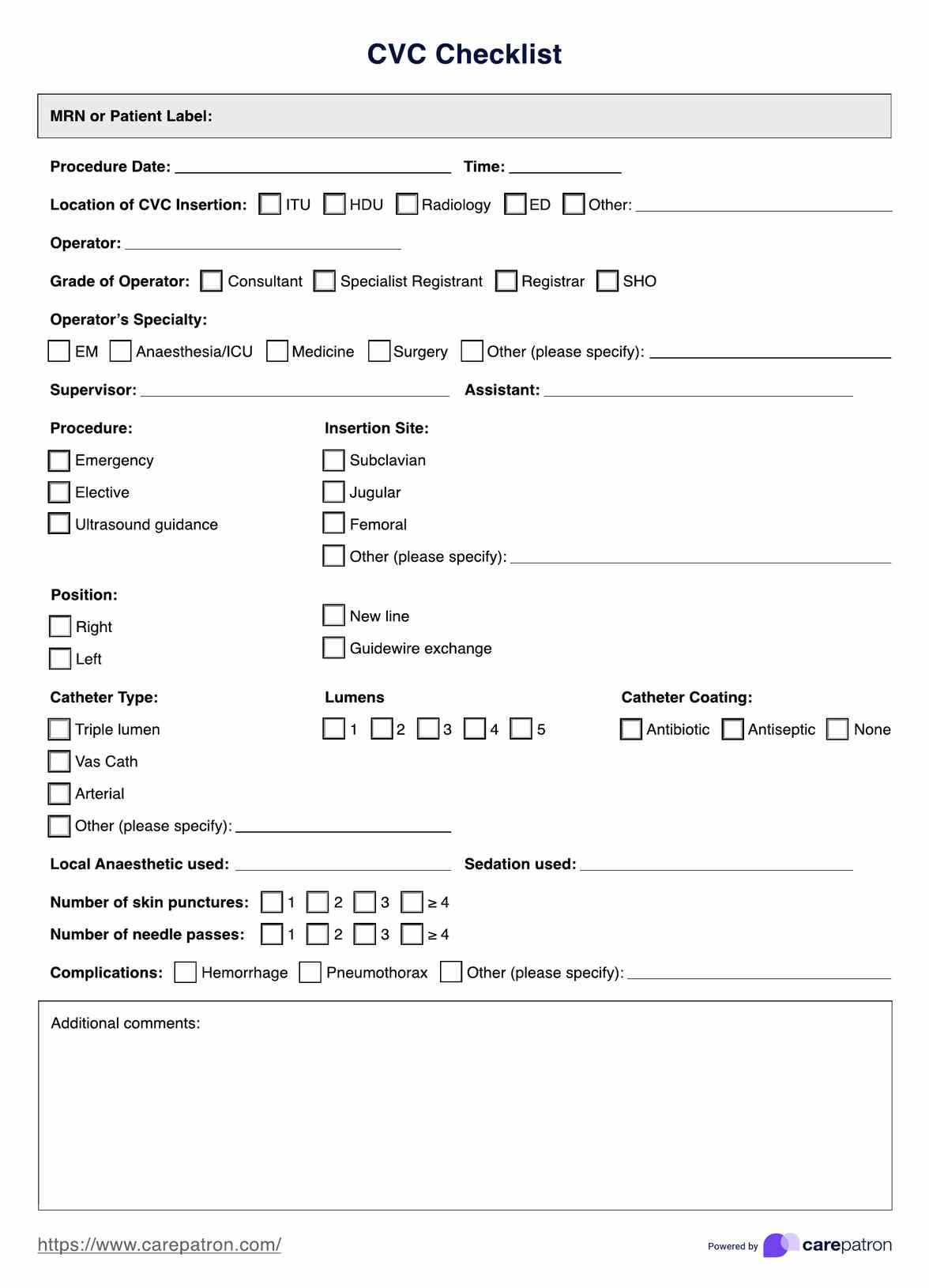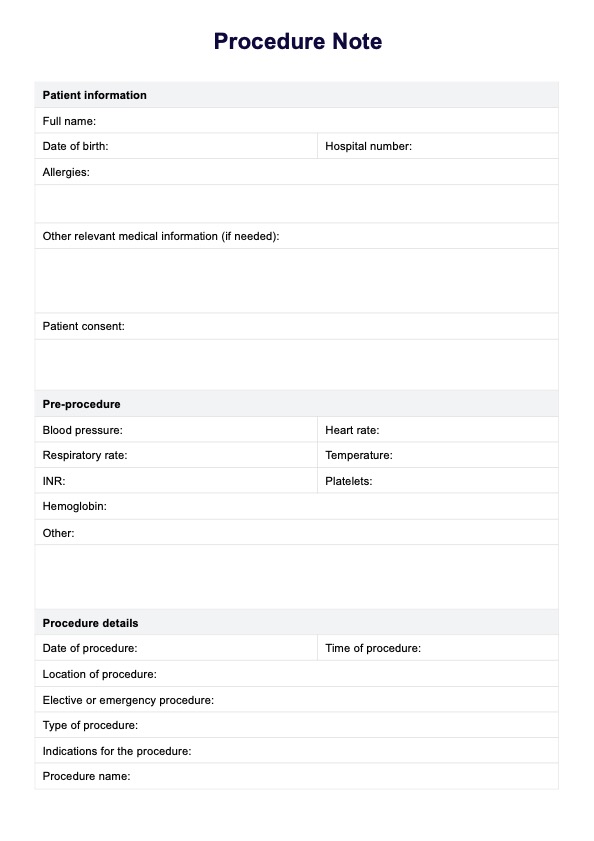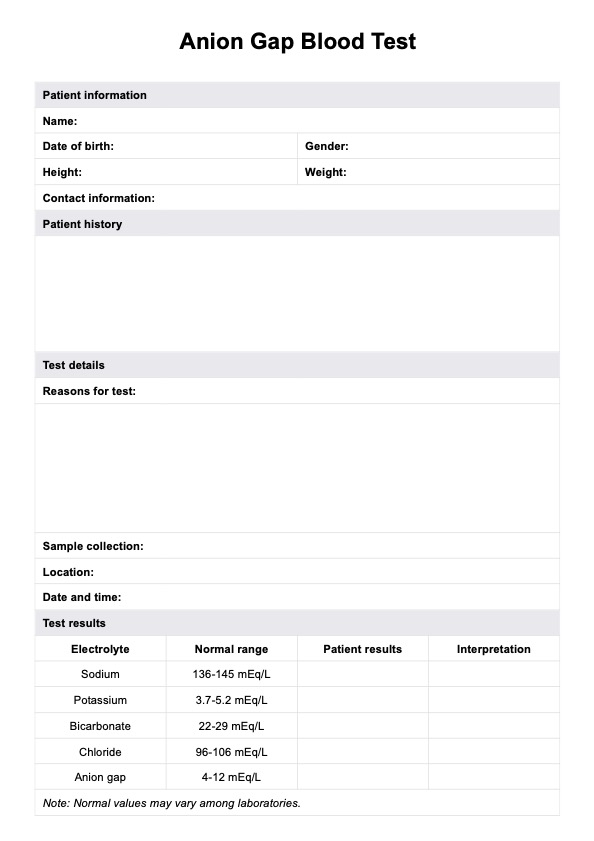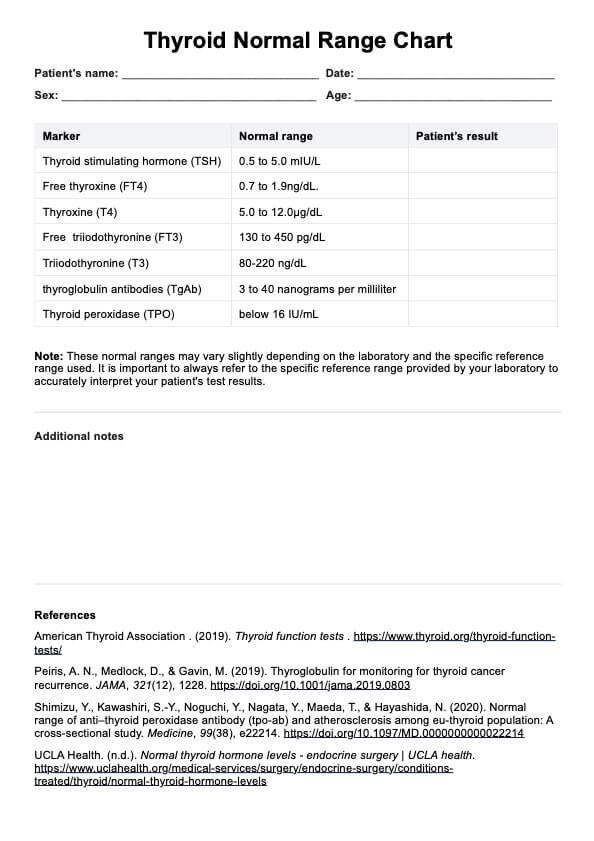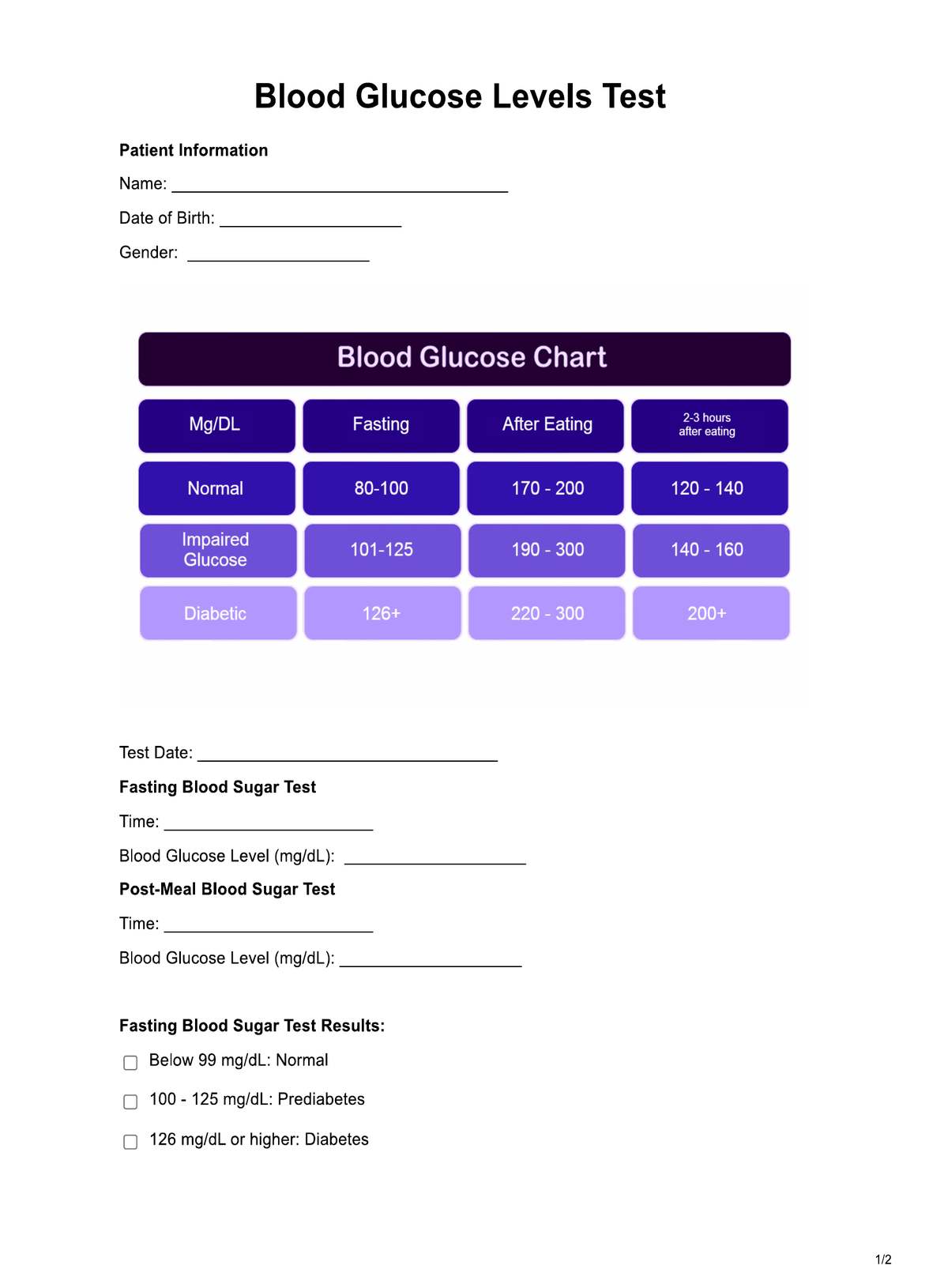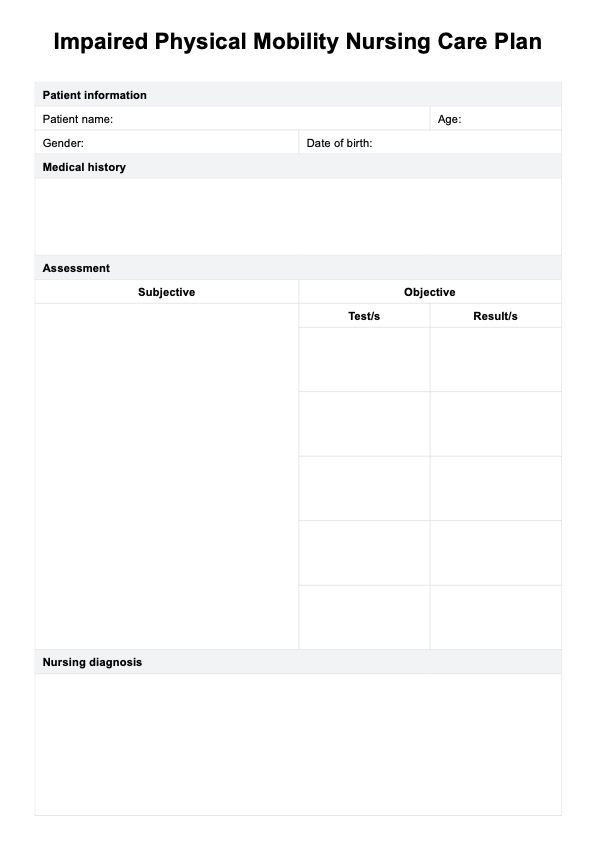CVC Checklist
Discover an essential CVC checklist for efficient business operations. Streamline your processes and enhance productivity with our comprehensive guide.


What is a central venous catheter (CVC)?
A Central Venous Catheter (CVC), also known as a central line, is a long, flexible tube that's inserted through a vein and threaded into a large vein near the heart, usually the superior vena cava or the inferior vena cava, or within the right atrium of the heart.
This positioning allows for the direct measurement of pressures in the heart and the administration of medications, fluids, blood products, and nutritional solutions. It can also be used to draw blood for tests.
CVCs are different from standard intravenous (IV) lines in that they have a longer length, which allows them to deliver substances directly to the central circulatory system. This feature is particularly beneficial for treatments that require rapid effect or for substances that cannot be administered through smaller peripheral veins due to their potential to irritate the vein's lining or because they need to be diluted quickly by the bloodstream.
There are various types of CVCs, including:
- Peripherally inserted central catheter (PICC) - Inserted through a vein in the arm and threaded toward the heart.
- Tunneled catheter - Inserted through the skin and then tunneled through subcutaneous tissue before entering a central vein, often used for long-term therapy.
- Implantable port - Consists of a catheter connected to a small reservoir (the port) implanted under the skin, typically on the chest. Medication is administered by inserting a needle through the skin into the port.
- Non-tunneled catheter - Directly inserted into a vein in the neck, chest, or groin and used for short-term treatments in hospital settings.
CVCs are vital in critical care, oncology, and chronic illness management, allowing for administering treatments that cannot be given through regular IV lines. However, their use also comes with risks, such as infection, thrombosis, and mechanical complications (like misplacement or pneumothorax during insertion). Therefore, meticulous care and strict adherence to insertion and maintenance protocols are essential to minimize these risks.
CVC Checklist Template
CVC Checklist Example
How is a CVC used?
A Central Venous Catheter (CVC) is a versatile tool in medical care, primarily used in settings where patients require long-term intravenous access or when peripheral venous access is challenging or inadequate. Here are some of the primary uses of a CVC:
- Administration of medications and treatments: For cancer patients, a CVC allows the administration of chemotherapy drugs directly into the bloodstream, minimizing damage to smaller veins. For severe infections, especially those requiring long-term treatment, antibiotics can be delivered more efficiently through a CVC—continuous or intermittent pain medication delivery, especially in palliative care settings.
- Fluids and nutritional support: TPN provides necessary nutrients directly into the bloodstream for patients who cannot receive nutrition orally or via the gastrointestinal tract. In critical care, rapid fluid administration may be required to treat conditions like shock or severe dehydration.
- Blood products: Blood or blood products (like platelets or plasma) can be transmitted through a CVC.
- Hemodialysis: In patients with kidney failure, a CVC may be used for hemodialysis access when traditional arteriovenous fistulas or grafts are impossible.
- Monitoring central venous pressure (CVP): A CVC can measure CVP, which provides essential information about a patient's fluid status and cardiac function, especially in critical care settings.
- Blood sampling: Regular blood tests are necessary for many hospitalized patients. A CVC allows blood sampling without requiring repeated needle sticks, reducing discomfort and the risk of peripheral vein damage.
Insertion and care
The insertion of a CVC is typically performed under sterile conditions, often guided by ultrasound to reduce the risk of complications like arterial puncture or pneumothorax (lung collapse). The procedure can be done at the bedside in a hospital, operating room, or an interventional radiology suite, depending on the type of catheter and patient needs.
Once inserted, proper care and maintenance of the catheter are critical to prevent complications such as infection (e.g., CLABSI - Central Line-Associated Bloodstream Infection), occlusion (blockage), or thrombosis (formation of a blood clot inside the catheter). This includes regular site cleaning, changing dressings, flushing the catheter to maintain patency, and monitoring for signs of infection or other problems.
Because of the risks associated with CVCs, their use is carefully considered and removed as soon as they are no longer needed.
What safety precautions must professionals follow before using a CVC?
Ensuring safety during using a Central Venous Catheter (CVC) is crucial due to the potential for serious complications such as infection, thrombosis, and mechanical problems. Healthcare professionals follow a set of standardized precautions and protocols before, during, and after CVC insertion and use to minimize these risks. Here's a breakdown of crucial safety precautions:
Preparation
Proper preparation is vital to ensure a safe and successful procedure before inserting a CVC. The following steps are essential to help minimize risks and maximize patient outcomes.
- Patient consent: Obtain informed consent after explaining the procedure, its benefits, risks, and alternatives.
- Patient assessment: Evaluate for contraindications (e.g., infection at the insertion site, coagulopathy) and choose the most appropriate site and type of catheter based on the patient's condition and intended use.
- Hygiene: Perform hand hygiene thoroughly before handling the catheter or any related equipment.
Equipment and environment
You need the right equipment and a controlled environment. This helps with precision and reduces the risk of complications and infections. Before starting the procedure, it's important to take essential steps.
- Sterile technique: Use a sterile technique throughout the procedure. This includes wearing sterile gloves, gowns, and masks and using sterile drapes.
- Check equipment: Ensure all necessary equipment is available and in good working condition before beginning the procedure.
Insertion procedure
Inserting CVC requires precise technique and following safety protocols to ensure success and minimize risks. The right technology and techniques must be used during this stage to accurately place the catheter while preventing complications such as infections and mechanical injuries. Key factors that are important during the insertion procedure include:
- Ultrasound guidance: Use ultrasound guidance to visualize the vein, reduce the risk of arterial puncture, and confirm the appropriate placement of the catheter.
- Skin antisepsis: Apply appropriate antiseptic solutions to the skin at the insertion site to reduce microbial contamination. Commonly used antiseptics include chlorhexidine-alcohol solutions.
- Full barrier precautions: Use full barrier precautions during the insertion, including a sterile gown, gloves, mask, cap, and large sterile drape.
Post-insertion care
The focus shifts to maintaining the catheter’s position and preventing complications associated with its use after a successful CVC insertion. Proper post-insertion care safeguards the patient from infection and ensures the catheter functions as intended. This care includes several vital practices:
- Securement: Properly secure the catheter to prevent movement and accidental dislodgement.
- Dressing: Apply a sterile dressing over the insertion site to protect it from infection. The type of dressing (transparent semipermeable dressing or gauze and tape) may vary based on institutional policy and the patient's condition.
- Documentation: Document all details of the insertion procedure, including the insertion site, the type and size of the catheter, the number of attempts, and any complications.
Maintenance
Effective maintenance ensures the longevity and functionality of the catheter while preventing complications that could affect the patient’s health. Adhering to these maintenance practices minimizes the risk of complications and ensures CVC remains a safe and effective conduit for therapy.
- Regular inspection: Inspect the catheter site for signs of infection, inflammation, or other complications.
- Aseptic technique for accessing: Use an aseptic technique every time the catheter is accessed to administer medications, fluids, or blood sampling.
- Catheter care and hygiene: Regularly clean the catheter and change dressings according to protocol, usually every 5 to 7 days for transparent dressings and more frequently for gauze dressings.
- Education: Educate the patient and family about signs of infection or other complications to report immediately.
Monitoring and removal
The final stage in the lifecycle of a CVC involves vigilant monitoring and timely removal. This phase minimizes the risk of long-term complications associated with prolonged catheter use. Ensuring diligent monitoring and removal practices protects the patient from potential risks and contributes to the overall success of their treatment regimen.
- Prompt removal: Remove the CVC as soon as it is no longer needed to reduce the risk of long-term complications, especially infections.
- Observation after removal: Observe for any complications related to the catheter after its removal, such as bleeding or infection at the insertion site.
What is a CVC Checklist?
A CVC Checklist is a vital tool healthcare professionals use to enhance patient safety and reduce the risk of complications during the insertion, maintenance, and removal of Central Venous Catheters (CVCs).
This checklist is part of a broader approach to improving the quality of care in critical care and interventional radiology settings where central lines are prevalent. The checklist is a step-by-step guide, ensuring that all necessary precautions and best practices are followed meticulously.
A CVC Checklist is not just a document but a crucial component of patient care that enhances the safety and effectiveness of central line use. It helps minimize the risk of complications such as infection, thrombosis, and air embolism while improving the overall quality of care for patients requiring central venous access for treatment or monitoring.
What are the benefits of using a CVC Checklist?
Using a Central Venous Catheter (CVC) Checklist brings several significant benefits to patient care, particularly in critical care, surgery, and interventional radiology settings where central lines are commonly used. This tool is designed to standardize practices, ensure consistency, and minimize the risk of complications associated with CVC use.
Here are the key benefits of implementing a CVC Checklist:
Enhanced patient safety
The checklist promotes adherence to best practices and evidence-based protocols, significantly reducing the incidence of complications such as infections (including CLABSIs), thrombosis, and mechanical issues like air embolism and catheter misplacement. Patient safety is greatly enhanced by ensuring that every step is meticulously followed.
Reduction in infection rates
One of the most notable benefits of a CVC Checklist is the marked reduction in central line-associated bloodstream infections. By standardizing antiseptic practices, hand hygiene, and sterile barrier precautions, the checklist helps prevent the introduction of pathogens during insertion and maintenance of the CVC.
Improved compliance with best practices
The checklist reminds healthcare professionals to follow the established best practices and guidelines. This ensures that all necessary steps are taken for each CVC insertion, maintenance, and removal, improving compliance with infection control and patient safety protocols.
Enhanced team communication and coordination
Using a checklist fosters better communication and coordination among the healthcare team. Each member is aware of their role and responsibilities, and the checklist prompts discussions about the procedure, potential complications, and how to address them, ensuring a unified approach to patient care.
Documentation and accountability
The CVC Checklist also serves as a documentation tool, recording the adherence to critical steps in the insertion and maintenance processes. This documentation can be crucial for quality improvement efforts, audits, and when care needs to be reviewed or evaluated.
Commonly asked questions
Healthcare professionals use the CVC checklist to ensure all necessary safety measures and best practices are followed during the insertion, maintenance, and removal of Central Venous Catheters (CVCs). It aims to minimize complications, improve patient safety, and standardize care.
A Central Venous Catheter (CVC) includes a long, flexible tube inserted into a large vein (usually in the neck, chest, or groin) to administer medication, fluids, and blood products or to obtain blood tests and measure central venous pressure. It may have multiple lumens for different purposes.
Inserting a CVC involves selecting an appropriate vein and site, using sterile technique, equipment, and often ultrasound guidance, to place the catheter into the central venous system. The position is verified (typically with an X-ray), and the catheter is secured and covered with a sterile dressing.


